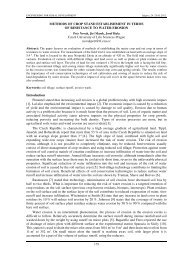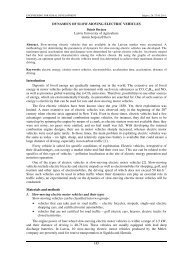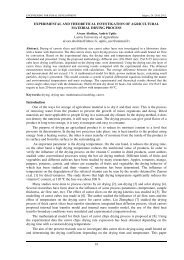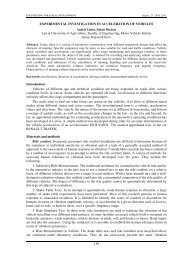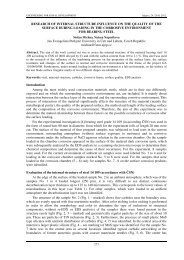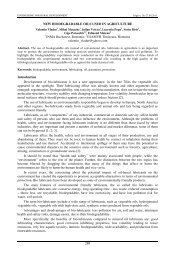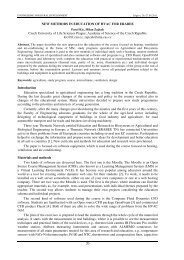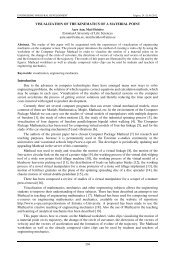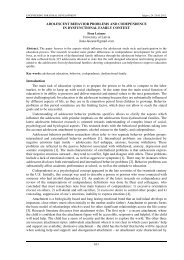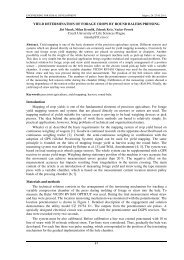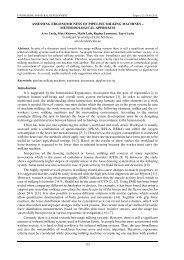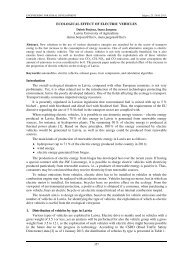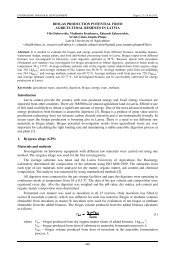impact of ethanol on fuel injection pump of diesel engine
impact of ethanol on fuel injection pump of diesel engine
impact of ethanol on fuel injection pump of diesel engine
- No tags were found...
You also want an ePaper? Increase the reach of your titles
YUMPU automatically turns print PDFs into web optimized ePapers that Google loves.
ENGINEERING FOR RURAL DEVELOPMENT Jelgava, 26.-27.05.2011.Irrespective <str<strong>on</strong>g>of</str<strong>on</strong>g> that we may c<strong>on</strong>clude that using <str<strong>on</strong>g>ethanol</str<strong>on</strong>g> does not cause ultrafast wear <str<strong>on</strong>g>of</str<strong>on</strong>g> the preciseunits <str<strong>on</strong>g>of</str<strong>on</strong>g> injectors.Fig. 4. Measurement results <str<strong>on</strong>g>of</str<strong>on</strong>g> geometric circularity <str<strong>on</strong>g>of</str<strong>on</strong>g> subsystem partsThe results <str<strong>on</strong>g>of</str<strong>on</strong>g> measuring the delivery valve retracti<strong>on</strong> collar geometric circularity revealed thereducti<strong>on</strong> <str<strong>on</strong>g>of</str<strong>on</strong>g> mean deflecti<strong>on</strong> in all secti<strong>on</strong>s. The reducti<strong>on</strong> <str<strong>on</strong>g>of</str<strong>on</strong>g> deflecti<strong>on</strong>s was caused by running in thedetails. We may c<strong>on</strong>clude that the operati<strong>on</strong> <str<strong>on</strong>g>of</str<strong>on</strong>g> the valves in <str<strong>on</strong>g>ethanol</str<strong>on</strong>g> envir<strong>on</strong>ment during 100 workhours does not cause significant wear that would lead to major changes in the capacity <str<strong>on</strong>g>of</str<strong>on</strong>g> the <strong>fuel</strong>supplyequipment. The same can be said to describe the wear <str<strong>on</strong>g>of</str<strong>on</strong>g> the plunger pairs. The greatest changein deflecti<strong>on</strong>, 1.667 µm, was found in the fourth plunger (Figure 4). The results gained from themeasurement <str<strong>on</strong>g>of</str<strong>on</strong>g> the hydraulic density <str<strong>on</strong>g>of</str<strong>on</strong>g> plunger pairs did not differ from the initial measurements,and the results corresp<strong>on</strong>ded to the factory requirements. Under the microscope <strong>on</strong>e can see barelynoticeable scratches <strong>on</strong> the surface <str<strong>on</strong>g>of</str<strong>on</strong>g> the plunger. More visible scratches <str<strong>on</strong>g>of</str<strong>on</strong>g> the work surface,however, are seen <strong>on</strong> the delivery valve retracti<strong>on</strong> collars (Figure 5), which, according to themeasurement results, did not change the hydraulic density according to the factory requirements.a b cdFig. 5. Work surface <str<strong>on</strong>g>of</str<strong>on</strong>g> subsystem: a – unloading collar before testing; b – unloading collar aftertesting; c – <strong>pump</strong> plunger before testing; d – <strong>pump</strong> plunger after testing.258



